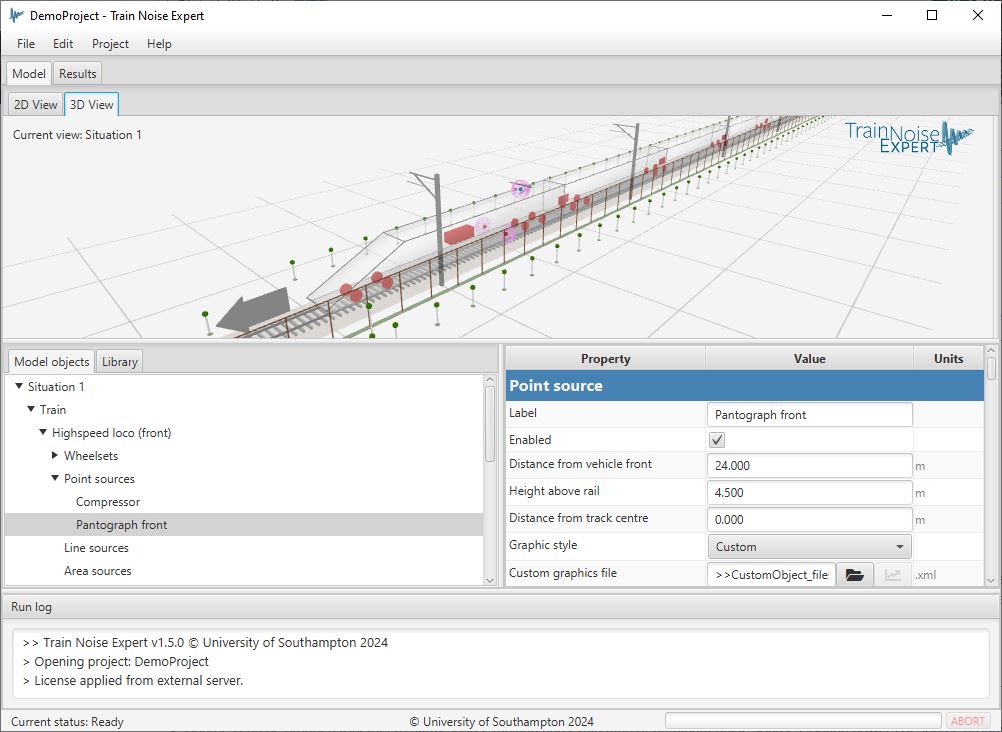Train Noise Expert is a software package developed by the Institute of Sound and Vibration Research (ISVR) at the University of Southampton, implementing findings from decades of research in railway noise. Our vision is for Train Noise Expert to be a ‘one-stop’ tool for accurately predicting noise from trains and railways.

The main Train Noise Expert user interface window.
The Train Noise Expert base software acts as an environment for specifying train and track parameters for various calculations, and for viewing/exporting results. The calculations that can be run depend on the options of your licence:
Rolling noise calculations
The rolling noise calculation option allows rolling noise sound powers and pressures as well as track decay rates to be calculated for wheel and track designs. Calculations are based on the well-known and validated ‘TWINS’ noise model approach. Key features of the Train Noise Expert rolling noise calculation option include:
- Wheel and rail roughness spectra can be input separately, or combined.
- Contact filter based on Remington or DPRS models.
- Track decay rates can be based on calculated or measured values.
- Wheel modal parameters derived from finite element model.
- Engineering models of rail and sleeper sound radiation including results from the latest research.
- Track can be specified as having continuous or discrete supports.
- Inclusion of track absorption effects (in beta).
External noise calculations
As key partners in the ACOUTRAIN European research project, ISVR developed software that calculates exterior noise for trains, both at pass-by and at standstill. The software, which was delivered in 2013, has been used and tested extensively by partners. Since the initial software, the functionalities have been substantially improved and incorporated as part of the external noise calculation option in Train Noise Expert. Key features of the Train Noise Expert external noise calculation option include:
- Standstill and pass-by noise predictions at ISO standard positions or user-defined positions.
- Noise sources defined as points, areas, lines and boxes with user-defined sound power / directivity as well as speed dependency.
- Rolling noise sources can be manually input as sound power spectra or, with the rolling noise option, automatically imported from previous rolling noise calculations.
- Predictions of noise levels in 1⁄3 octave bands and overall A-weighted level.
- Sources can be grouped together to allow source ranking and evaluation of dominant noise sources. Sound powers of source groups can be automatically fit to measured sound pressure level values.
- Vehicles can be copied and edited within a virtual train.
- Inclusion of Doppler effect for moving sources.
- Inclusion of ground absorption and trackside noise barrier effects.
- Powerful graphical interface including 2D and 3D view of the sources and receivers relative to the train.
Output
Sound pressure levels are calculated for any arbitrary receiver position, and/or at the ISO 3095 standard positions. For pass-by conditions, a time profile of the sound pressure level is also calculated. Results are calculated in 1⁄3 octave bands and can be shown with or without A-weighting. Overall results are also calculated, in terms of Leq,Tp, Lmax and SEL metrics. Auralisation of pass-by noise levels is also available as option.
Results may be grouped arbitrarily and are viewable as interactive plots in the software. Data can also be exported as data tables (CSV format).
Sound power terms may also be exported for integration with environmental noise mapping software, with the following protocols supported: CNOSSOS-EU, RMR, TNPM and Harmonoise/IMAGINE.
Ongoing development
We are committed to the continuous improvement of Train Noise Expert, and are actively including results and techniques from the latest railway noise research. We have a list of new/improved features currently in development, and we provide fast support to our clients. When you purchase a licence from us, it comes with 2 years of technical support, which includes maintenance updates. Further updates can be provided through an annual support contract.
More information
For more details, and to obtain a demo copy, please contact us.

